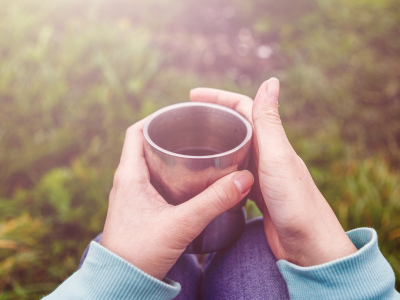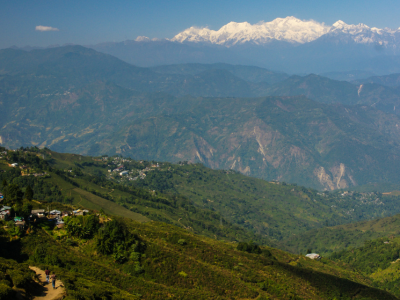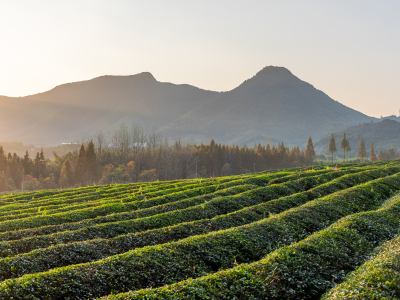Black Tea Adventure Pt. 2

This week, we're continuing our exploration of unflavored black teas by tasting two classics and one fascinating newcomer. We'll be looking at an Assam, of that eponymous region in India, a Keemun, from Anhui province in China, and then a large-leafed tea from the newly initiated region of Guatemala. While the first two are traditionally mixed into English Breakfast blends, (Keemun typically used only in the more expensive ones), our Guatemala Maya is an example of a completely different terroir, processing method, and flavor profile.
While it has essentially only been available to the US market in the last five years, people began cultivating tea in Guatemala a little over a century ago. Colonial Germans (much like they had done in Tanzania) likely introduced it due to Guatemala's noticeable geographical assets. Perhaps they noticed that Guatemala shared a latitude (as well as some weather patterns) with India's Nilgiri region, known for its dark, large-leafed, aromatic black teas. By the look of the leaves alone, our Guatemala Maya looks like a New World answer to great Nilgiri teas.
Assam Breakfast utilizes the large-leafed variety of the tea plant as well (technically: Camellia Sinensis Assamica), however Assam is known for heavily broken teas which are brisk, malty, and smooth. This processing method cultivates the qualities in the tea that produce the ideal body and flavor profile for the tea to pair well with milk. Integral to Assam's fame, the tea must stand up to milk because it is used in blends at the center of many British tea traditions where milk would be as common as cream would for coffee.
Keemun Hao Ya grows the farthest north of any among this group of black teas, and is made from the tea plant's smaller-leafed variety, Camellia Sinensis Sinensis. This tea bush is native to China and ideally suited for the vastly different terroir of that region. More importantly, Keemun is one of China's “Ten Most Famous Teas” because of its incomparably magnificent flavor and aroma. Though we've given it a brief one, it hardly needs an introduction.
Without further ado, let's get started with the tasting!

Appearance & aroma of dry leaves
Though the dry leaves carry a subtle aroma, many would find them non-aromatic. Importantly, that is not a flaw. Introverted teas like this one often need to be unlocked through the brewing process to truly express their character. More noticeable than the aroma is the size of the leaves—and though this may seem to be a superficial concern, this fact stands out as unique among the black teas of the world. Look at most tea bags, even the loose-leaf sachets from higher-end providers—what will you see? A heavily broken product, resembling not leaves, but something between dust and a larger grind of coffee. The contrast here communicates that the tea ought to be less brisk and malty, and instead rather delicate, subtle, and less tannic. Not as a rule, but most of the time, large-leafed teas lend themselves to nuance and delicacy, while broken teas bring strength, body, tannin, etc.
Specifically: these large leaves are dark brown in color, almost black, with wisps of reddish brown. Twisted and still mostly whole, they are reminiscent of Wuyi Oolong leaves. The subtle aromas send you searching for them, but once found, there really is a bevy of activity: licorice, cinnamon, spice cabinet, sugared currant, cherry—they are even a little nutty / woody.
Brewing methodWith bulkier (lighter weight / less dense) teas, of which most large-leafed teas are, be very skeptical of non-weight based brewing instructions. For instance, though the brewing instructions for this tea suggest 1 heaping teaspoon per 8oz of water, that heaping teaspoon in my measurements could weigh anywhere from less than 1.5 grams, to as much as 2.5 grams. At 1.5 grams, your tea will be noticeably thin and faint. At 2 to 2.5 grams, the tea develops more astringency, body, and tannin—and at the high end, will become stronger (if less refined). The sweet-spot seems to be about 2 grams per 8oz, at around 4 minutes. Longer steepings tended to bring out astringency and coarseness.
Appearance & aroma of brewed tea and infused leaves
The infusion is copper in color, or caramel brown/tawny. The dominant aromas are earthy—wood, dead leaves, and maybe a whiff of the inside of a spice cabinet (with the spices recently removed). That may not appetize every palate, but these muscular, natural aromas are part of the pleasure of the world's best black teas. And also, faintly, there is sweetness to be found in the cup—maybe raisin or cinnamon on buttered toast. A little bit of the nutty aroma of the dry leaves remains too, perhaps almond. Finally, the infused leaves are a picture of Guatemala Maya's singularity, as the full unfurled leaves look far more like an oolong than a black tea.
Though this tea can be brewed to attain a fair amount of astringency, it is typically a medium bodied, medium astringent black tea. The fascinating texture is soft, but not in the flowery, delicate way of a Darjeeling. It is smooth, almost oily or waxy—a very satisfying tea on its own, but with enough structure to hold up to a bit of milk. Tannin is lower than a typical black tea due to its large, mostly unbroken leaves. This being said, astringency and tannin can of course be increased in the brew by using more tea over longer steeping times.
Flavor & finish
The taste delivers what the nose advertises—the tea is a bit nutty, with some raisin, some cinnamon. A fine breakfast pastry of a tea! There are brief top notes of cocoa/caramel, and a sense of honeyed grain. You'll find tertiary fruit characteristics too, if you're looking for them—there's fig, red apple, peppered tomato. Finally, the slight cooked-greens bitterness of the finish is buoyed by significant malty-ness, even if the finish may not be very lengthy. It's not on the upper echelon in terms of complexity or refinement, but that's no crime, as it's still a unique example of a quality tea from a totally new terroir. We'll definitely be excited to see what Guatemala can do with tea in the future.

Appearance & aroma of dry leaves
A classic Assam, these brown leaves have some gold (evidence of their tippiness), and are rolled and very cut/broken. No piece is larger than a centimeter in length. Assams are not known for being very aromatic, but one does find some black licorice on the nose, with hints of fruit underneath. As typical with black tea, there are some dry, savory, earthy tones: wood, maple, toast. But the secondary dried fruit notes are the real highlight—raisin, fig, and maybe some plum or cherry.
Brewing method
One heaping tsp is pretty reliably 2.5 g/8 oz, which is a good balance, so we mostly followed that ratio and instead found the question to be more about brewing time. At 3 minutes, the tea was very muted, thin, and didn't stand up to milk (as it ought to). At 5 minutes, the tea's astringency peaked, and seemed almost out of balance with the flavors therein. At 4 to 4.5 minutes though, the tea seemed to develop enough body and astringency (thus pairing well with milk) while still offering maltyness, smoothness, and flavor. For the best traditional Assam experience, about 4 to 4.5 minutes should do the trick.
While we do not recommend resteeping this tea, we would suggest using more tea and very short steeping times for a very different (and good) experience. Using 3.5 grams of tea and only steeping for 1.5 minutes, one can brew a cup with reduced astringency, rounded maltyness, and a nice balance between fruit and tannin that does not call for milk. Think of it as sort of a Western Gong Fu.
Appearance & aroma of brewed tea and infused leaves
The cut leaves, starting out as small as they do, do not change much in the infusion, though their aroma is more lively once infused. The liquor itself is translucent dark brown with a red hue (which is why black teas are known as red teas in China: for the red color of the infusion). The aroma is understated; the fruit on the nose is perhaps fig, dates, fruit skin—and maybe dried flowers. But seeing as Assamica-based black teas from India and Sri Lanka are the most familiar to the typical American palate, it will nonetheless be a recognizable and comforting aroma. Mostly, it smells like black tea!
Body/mouthfeel/astringency
The astringency awakens the palate on the attack, and threads evenly through the finish. Yet, the tea doesn't quite seem bitter, perhaps because of the balance it maintains with its thick, full-bodied texture. The final result is a rounded smoothness on the finish, the medium tannins softening as they spread across the palate. It is this muscular structure which allows the tea to pair so easily and marvelously with milk.
The fruit notes hinted at in the aroma come through most significantly on the palate: fig, raisin, apple skin—but it's the savory notes that nonetheless dominate the experience. The malt, nuttiness, bread crust, nutmeg, and paper (like the way books smell), all provide a comforting counterpoint to the piquant astringency threaded throughout. On the short finish, the rounded tannin is highlighted by an echo of vanilla and licorice, recalling that subtle aroma of the dry leaves. Ultimately though, it's not a deeply layered or complex tea—and it's not really supposed to be. It's a simple, reliable black tea that's often more enjoyable with the creamy addition of milk, but worth trying without—and a great way to start the day.

Appearance & aroma of dry leaves
The leaves are tiny, wiry, and extremely dark in color—black with hints of brown, in contrast to the Assam's dark brown with hints of gold. Importantly, these leaves are also more uniform than the Assam (which is evidence of its careful shaping). One of the most intensely fragrant black teas, this high-end Keemun also features a bevy of disparate aromatics. There are notes of anise (or licorice), tobacco, wood (oak?), smokiness, baking chocolate, pie crust, baking spice, bread, fig, and black currant—like a great wine, simply smelling it is a rewarding sensory experience.
Brewing method
One heaping teaspoon of this dense tea will easily give you 2.5 to 3g, which is great for an 8oz cup. Again, the key differences emerge across different steeping times. Regarding this, let's directly quote panelist Melissa Finefrock: “At 3 min, the aftertaste is amazing and the mouthfeel is smooth, but I think it may be too ethereal. If I’m in the mood for that shorter brew time, I might [use] more tea... At 4 min, I get more of a toasty vibe and start to taste that distinctive black tea smell. At 5 min, the smokiness really, really comes through, and so does a minerality.” In line with our other panelists, the tea's delicate top notes were more available at shorter brew times, and a satisfying earthy, smoky intensity came through on longer brew times.
Another option would be the Gong Fu brewing method. Using more tea (5 to 6 grams) in a smaller pot (6 to 8 oz) coaxes out a ton of of those delightful top notes and subtle nuances at a mere 1 to 1.5 minute infusion. Subsequent infusions of 1.5 to 2 minutes each will unveil those great cocoa, caramel, tobacco, earth, mushroom, and smoke flavors, yet also retain a sense of the Keemun's full-bodied intensity. Most black teas do not take well to multiple infusions, but the Keemun is complex and high-quality enough to shine via the Gong Fu method.
Appearance & aroma of brewed tea and infused leaves
The infusion is translucent chocolate brown, with the baking spice, unsweetened chocolate, and bready/toast aromas really coming through. Also, some dominant earthy aromas have developed: fresh soil, malt, dried/crushed flowers, something fermented—reminiscent of Pu'er in some ways. The leaves, again, do not change significantly, being very small and cut leaves of the Camellia Sinensis Sinensis variety.
Body/mouthfeel/astringency
The tea is full bodied with medium tannin—seeming very dry, and fairly astringent—but less so than the Assam. And because the astringency takes a second to develop (rather than jumping out as the first thing one notices), the Keemun seems bolder and smoother than the Assam, even though it can still stand up to milk when brewed long.
As much as any of the five black teas we've tasted, this is a COMPLEX tea. It's boldness holds the earthy, spicy, woody flavors in balance—all present, but not overwhelming. The Keemun's minerality and smokiness are the first thing you may notice, but there are also top notes of cocoa, caramel, vanilla and oak—a combination almost like a fine bourbon. The long smooth finish lingers with tertiary fruit notes—raisin, plum, black currant—flavors predicted in the prior aromas. For all its delicacy though, this is a tea that more than any other pairs with whiskey, cigars, and steak char—a bold and muscular version of beauty—an expression of the tea leaf that really must be tasted to be appreciated.
ConclusionBlack teas are both a classic and unappreciated genre. They are often appreciated for their value, accessibility, and simplicity—but rarely for their greatness. I hope that this peek into the variety of terroirs, production styles, and flavor profiles provides an opportunity to revisit the world of black tea with an open mind and focused palate.
We should also say that these Taste Adventures are truly meant to be shared, and if you would like to enjoy and indulge in any of these taste adventures, do not hesitate to call or email us. We also welcome any questions or comments via email, so please don't be shy. Be sure to stay tuned for our next tea adventure, and we'll catch you next time!



Comments